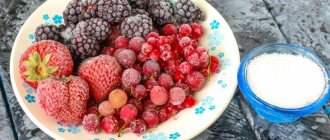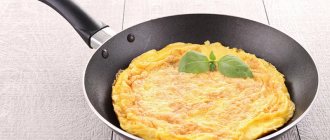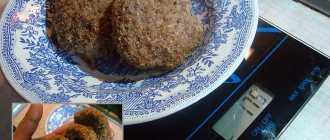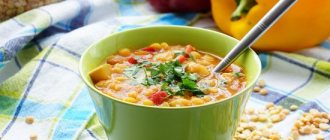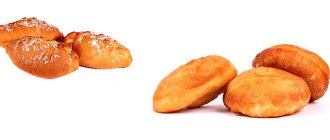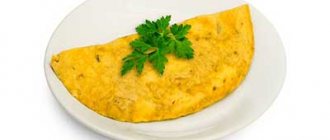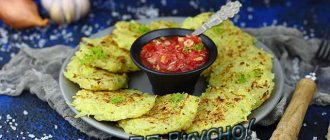Composition of zucchini and its nutritional value
The usefulness of zucchini is determined by the vitamins, micro- and macroelements it contains.
Nutritional value determines the amount of fat, protein and carbohydrates per 100 grams of vegetable product.
| Vitamins | Microelements | Macronutrients | The nutritional value |
| Vitamin C 15 mg | Iron 0.4 mg | Potassium 238 mg | Proteins 0.6 g |
| Vitamin H 0.4 mg | Calcium 15 mg | Carbohydrates 4.6 g | |
| Vitamin A 5 mcg | Phosphorus 12 mg | Fat 0.3 g | |
| Vitamin PP 0.6 mg | Sodium 2 mg | Water 93 g | |
| Vitamin B1 0.03 mg | Magnesium 9 mg | Fatty acids Saturated 0.1 g | |
| Vitamin B2 0.03 mg | Fatty acids Unsaturated 0.1 g | ||
| Vitamin B5 0.1 mg | Dietary fiber 1 g | ||
| Vitamin B6 0.1 mg | Organic Acids 0.1 g | ||
| Vitamin B9 14 mcg | Ash 0.4 g | ||
| Vitamin E 0.1 mg | |||
| Beta-carotene 0.03 mg | |||
| Calorie content: 24 kcal |
What substances does the vegetable contain?
The vegetable contains such a number of elements and vitamins that its value is irreplaceable for the body.
Includes:
- complex of vitamins: A, C, B1, PP, B2.
- pectins;
- organic acids;
- cellulose;
- minerals: potassium, lithium, iron, calcium, molybdenum, zinc, sodium and phosphorus.
These substances help keep the entire body in good shape and eliminate many diseases.
One hundred grams of raw zucchini contains 24 kilocalories.
Fried zucchini recipe and nutritional value
Ingredients:
- Zucchini – 500 grams;
- Egg – 2 pieces;
- Flour – 1 tablespoon;
- Vegetable oil – 100 g
Cooking method:
Cut the zucchini into circles, mix the flour and eggs thoroughly.
Dip each circle in a mixture of eggs and flour, fry in a frying pan with hot vegetable oil.
You can also spread each fried zucchini circle with mayonnaise and garlic; the calorie content of such a dish will be 94 kcal per 100 grams of product.
Calorie content of products and finished dishes:
| Product | Measure | Weight, g | Fats, g | Proteins, g | Carbohydrates, g | Calorie content, kcal |
| zucchini | 500 g | 500 | 1,5 | 3 | 23 | 120 |
| Egg | 2 pieces | 94 | 10,24 | 11,94 | 0,66 | 147,58 |
| Flour | 1 spoon | 25 | 0,3 | 2,3 | 18,72 | 85,5 |
| Vegetable oil | 100 | 99,9 | 0 | 0 | 899 | |
| Total per 100 g | 719 100 | 111,94 15,56 | 17,24 2,39 | 42,38 5,89 | 1252,08 174,14 |
Calorie content of zucchini per 100 grams of product
| Zucchini dish | per 100 grams of product |
| raw zucchini | 15-20 kcal |
| fried zucchini without oil | 25 kcal |
| fried zucchini with butter | 80 kcal |
| zucchini pancakes | 90 kcal |
| fried zucchini with garlic | 100 kcal |
| steamed zucchini | 20 kcal |
| zucchini cooked in the oven | 24 kcal |
| stewed zucchini | 60 kcal |
| stewed zucchini with sour cream | 65 kcal |
| zucchini with cheese in the oven | 100 kcal |
| fried zucchini with egg | 105 kcal |
The table shows that the least high-calorie dish made from zucchini is, of course:
- raw zucchini - 15-20 kcal per 100 grams of product, then comes
- steamed zucchini - 20 kcal,
- zucchini cooked in the oven - 24 kcal,
- fried zucchini without oil - 25 kcal,
- stewed zucchini - 60 kcal,
- stewed zucchini with sour cream - 65 kcal,
- fried zucchini with butter - 80 kcal,
- zucchini pancakes - 90 kcal,
- fried zucchini with garlic - 100 kcal,
- zucchini with cheese in the oven - 100 kcal,
- fried zucchini with egg - 105 kcal.
The calorie content of a product depends on such ingredients as the amount of butter, cheese, flour in the prepared dish. In this case we are talking about zucchini.
Zucchini fritters nutrition facts
Ingredients:
- Zucchini - 250 g;
- Flour - 2.5 tablespoons;
- Egg 1 - piece
- Vegetable oil - 20 ml
- Salt.
Cooking method:
Wash the zucchini well and peel off the skin with a knife.
Cut lengthwise, remove the inside, along with the seeds.
Scroll through a meat grinder, or take a medium grater and grate them.
Add eggs, salt, flour and mix everything thoroughly.
Heat the oil in a frying pan, spoon the zucchini mass into the pan, fry on both sides for 7 minutes.
Recipe for fried zucchini with egg. Calorie, chemical composition and nutritional value.
Nutritional value and chemical composition of “fried zucchini with egg.”
The table shows the nutritional content (calories, proteins, fats, carbohydrates, vitamins and minerals) per 100 grams of edible portion.
| Nutrient | Quantity | Norm** | % of the norm in 100 g | % of the norm in 100 kcal | 100% normal |
| Calorie content | 105.5 kcal | 1684 kcal | 6.3% | 6% | 1596 g |
| Squirrels | 3.5 g | 76 g | 4.6% | 4.4% | 2171 g |
| Fats | 8.6 g | 56 g | 15.4% | 14.6% | 651 g |
| Carbohydrates | 3.5 g | 219 g | 1.6% | 1.5% | 6257 g |
| Organic acids | 0.1 g | ~ | |||
| Alimentary fiber | 1 g | 20 g | 5% | 4.7% | 2000 g |
| Water | 78.5 g | 2273 g | 3.5% | 3.3% | 2896 g |
| Ash | 2.1414 g | ~ | |||
| Vitamins | |||||
| Vitamin A, RE | 64.5 mcg | 900 mcg | 7.2% | 6.8% | 1395 g |
| Retinol | 0.051 mg | ~ | |||
| beta carotene | 0.036 mg | 5 mg | 0.7% | 0.7% | 13889 g |
| Vitamin B1, thiamine | 0.038 mg | 1.5 mg | 2.5% | 2.4% | 3947 g |
| Vitamin B2, riboflavin | 0.128 mg | 1.8 mg | 7.1% | 6.7% | 1406 g |
| Vitamin B4, choline | 57.4 mg | 500 mg | 11.5% | 10.9% | 871 g |
| Vitamin B5, pantothenic | 0.398 mg | 5 mg | 8% | 7.6% | 1256 g |
| Vitamin B6, pyridoxine | 0.142 mg | 2 mg | 7.1% | 6.7% | 1408 g |
| Vitamin B9, folates | 15.655 mcg | 400 mcg | 3.9% | 3.7% | 2555 g |
| Vitamin B12, cobalamin | 0.119 mcg | 3 mcg | 4% | 3.8% | 2521 g |
| Vitamin C, ascorbic acid | 7.23 mg | 90 mg | 8% | 7.6% | 1245 g |
| Vitamin D, calciferol | 0.503 mcg | 10 mcg | 5% | 4.7% | 1988 |
| Vitamin E, alpha tocopherol, TE | 2.796 mg | 15 mg | 18.6% | 17.6% | 536 g |
| Vitamin H, biotin | 5.021 mcg | 50 mcg | 10% | 9.5% | 996 g |
| Vitamin K, phylloquinone | 0.1 mcg | 120 mcg | 0.1% | 0.1% | 120000 g |
| Vitamin RR, NE | 1.526 mg | 20 mg | 7.6% | 7.2% | 1311 g |
| Niacin | 0.537 mg | ~ | |||
| Macronutrients | |||||
| Potassium, K | 247.19 mg | 2500 mg | 9.9% | 9.4% | 1011 g |
| Calcium, Ca | 32.44 mg | 1000 mg | 3.2% | 3% | 3083 g |
| Magnesium, Mg | 11.49 mg | 400 mg | 2.9% | 2.7% | 3481 g |
| Sodium, Na | 632.65 mg | 1300 mg | 48.7% | 46.2% | 205 g |
| Sera, S | 43.04 mg | 1000 mg | 4.3% | 4.1% | 2323 g |
| Phosphorus, P | 55.8 mg | 800 mg | 7% | 6.6% | 1434 g |
| Chlorine, Cl | 961.1 mg | 2300 mg | 41.8% | 39.6% | 239 g |
| Microelements | |||||
| Iron, Fe | 0.97 mg | 18 mg | 5.4% | 5.1% | 1856 |
| Yod, I | 4.57 mcg | 150 mcg | 3% | 2.8% | 3282 g |
| Cobalt, Co | 2.519 mcg | 10 mcg | 25.2% | 23.9% | 397 g |
| Manganese, Mn | 0.0105 mg | 2 mg | 0.5% | 0.5% | 19048 |
| Copper, Cu | 23.18 mcg | 1000 mcg | 2.3% | 2.2% | 4314 g |
| Molybdenum, Mo | 3.078 mcg | 70 mcg | 4.4% | 4.2% | 2274 g |
| Selenium, Se | 7.249 mcg | 55 mcg | 13.2% | 12.5% | 759 g |
| Fluorine, F | 12.58 mcg | 4000 mcg | 0.3% | 0.3% | 31797 g |
| Chromium, Cr | 0.91 mcg | 50 mcg | 1.8% | 1.7% | 5495 g |
| Zinc, Zn | 0.2631 mg | 12 mg | 2.2% | 2.1% | 4561 g |
| Digestible carbohydrates | |||||
| Mono- and disaccharides (sugars) | 4 g | max 100 g | |||
| Essential amino acids | |||||
| Arginine* | 0.1807 g | ~ | |||
| Valin | 0.1761 g | ~ | |||
| Histidine* | 0.0778 g | ~ | |||
| Isoleucine | 0.1372 g | ~ | |||
| Leucine | 0.247 g | ~ | |||
| Lysine | 0.2058 g | ~ | |||
| Methionine | 0.096 g | ~ | |||
| Methionine + Cysteine | 0.1647 g | ~ | |||
| Threonine | 0.1395 g | ~ | |||
| Tryptophan | 0.0457 g | ~ | |||
| Phenylalanine | 0.1486 g | ~ | |||
| Phenylalanine+Tyrosine | 0.2584 g | ~ | |||
| Nonessential amino acids | |||||
| Alanin | 0.1624 g | ~ | |||
| Aspartic acid | 0.2813 g | ~ | |||
| Glycine | 0.096 g | ~ | |||
| Glutamic acid | 0.4048 g | ~ | |||
| Proline | 0.0915 g | ~ | |||
| Serin | 0.2127 g | ~ | |||
| Tyrosine | 0.1098 g | ~ | |||
| Cysteine | 0.0663 g | ~ | |||
| Sterols (sterols) | |||||
| Cholesterol | 130.35 mg | max 300 mg | |||
| beta sitosterol | 11.6279 mg | ~ | |||
| Saturated fatty acids | |||||
| Saturated fatty acids | 1.4 g | max 18.7 g | |||
| 14:0 Miristinovaya | 0.0091 g | ~ | |||
| 15:0 Pentadecane | 0.0023 g | ~ | |||
| 16:0 Palmitinaya | 0.8293 g | ~ | |||
| 17:0 Margarine | 0.0069 g | ~ | |||
| 18:0 Stearic | 0.4396 g | ~ | |||
| 20:0 Arakhinovaya | 0.0243 g | ~ | |||
| 22:0 Begenovaya | 0.0407 g | ~ | |||
| Monounsaturated fatty acids | 2.5203 g | min 16.8 g | 15% | 14.2% | |
| 16:1 Palmitoleic | 0.0892 g | ~ | |||
| 17:1 Heptadecene | 0.0023 g | ~ | |||
| 18:1 Oleic (omega-9) | 2.3132 g | ~ | |||
| 20:1 Gadoleic (omega-9) | 0.0091 g | ~ | |||
| Polyunsaturated fatty acids | 3.7649 g | from 11.2 to 20.6 g | 33.6% | 31.8% | |
| 18:2 Linolevaya | 3.7283 g | ~ | |||
| 18:3 Linolenic | 0.0137 g | ~ | |||
| 20:4 Arachidonic | 0.0229 g | ~ | |||
| Omega-6 fatty acids | 0.3 g | from 4.7 to 16.8 g | 6.4% | 6.1% |
The energy value of zucchini fried with egg is 105.5 kcal.
Primary Source: Created in the application by the user. Read more.
** This table shows the average levels of vitamins and minerals for an adult. If you want to know the norms taking into account your gender, age and other factors, then use the “My Healthy Diet” application.
Zucchini
Calories, kcal: 24 Proteins, g: 0.6 Fats, g: 0.3 Carbohydrates, g: 4.6
Zucchini is usually called a herbaceous annual of the Cucurbitaceae family, the closest relative of the common pumpkin. Zucchini fruits have an elongated oval shape, light green, yellow or almost white (calorizator). The pulp of the zucchini is dense and elastic, the young vegetables are very juicy, and inside the fruit there are numerous seeds, which were originally used as food. The first to use zucchini were the inhabitants of Mexico and Central America, where, along with corn and beans, zucchini was considered the main, and sometimes the only food. The strange vegetable came to Europe only in the 16th century, and zucchini flowers fried in batter were considered a delicacy and were very expensive.
Calorie content of zucchini
The calorie content of zucchini is 24 kcal per 100 grams of product.
Composition and beneficial properties of zucchini
Zucchini contains structured water, which is extremely useful for the functioning of the gastrointestinal tract and the normalization of all digestive processes. The vegetable contains: vitamins A, B1, B2, C, PP, as well as micro- and macroelements necessary for the human body: potassium, calcium, magnesium, zinc, copper and manganese, iron, sulfur, molybdenum, titanium, aluminum, phosphorus and sodium. Dietary fiber and cellulose present in the product provide active assistance in metabolic processes, promote the elimination of unnecessary waste and toxins, and stimulate the intestines. Zucchini helps lower cholesterol levels in the blood, reduce swelling, and has a positive effect on vision and overall tone of the body.
How many calories are in fried zucchini without oil?
Nutritional value and chemical composition of “Zucchini fried without oil.”
The table shows the nutritional content (calories, proteins, fats, carbohydrates, vitamins and minerals) per 100 grams of edible portion.
| Nutrient | Quantity | Norm** | % of the norm in 100 g | % of the norm in 100 kcal | 100% normal |
| Calorie content | 25.7 kcal | 1684 kcal | 1.5% | 5.8% | 6553 g |
| Squirrels | 0.7 g | 76 g | 0.9% | 3.5% | 10857 g |
| Fats | 0.3 g | 56 g | 0.5% | 1.9% | 18667 |
| Carbohydrates | 4.8 g | 219 g | 2.2% | 8.6% | 4563 g |
| Organic acids | 0.1 g | ~ | |||
| Alimentary fiber | 1.2 g | 20 g | 6% | 23.3% | 1667 g |
| Water | 89.9 g | 2273 g | 4% | 15.6% | 2528 g |
| Ash | 0.454 g | ~ | |||
| Vitamins | |||||
| Vitamin A, RE | 4.9 mcg | 900 mcg | 0.5% | 1.9% | 18367 g |
| beta carotene | 0.029 mg | 5 mg | 0.6% | 2.3% | 17241 g |
| Vitamin B1, thiamine | 0.027 mg | 1.5 mg | 1.8% | 7% | 5556 g |
| Vitamin B2, riboflavin | 0.034 mg | 1.8 mg | 1.9% | 7.4% | 5294 g |
| Vitamin B4, choline | 10.9 mg | 500 mg | 2.2% | 8.6% | 4587 g |
| Vitamin B5, pantothenic | 0.112 mg | 5 mg | 2.2% | 8.6% | 4464 g |
| Vitamin B6, pyridoxine | 0.099 mg | 2 mg | 5% | 19.5% | 2020 |
| Vitamin B9, folates | 7.683 mcg | 400 mcg | 1.9% | 7.4% | 5206 g |
| Vitamin C, ascorbic acid | 8.98 mg | 90 mg | 10% | 38.9% | 1002 g |
| Vitamin E, alpha tocopherol, TE | 0.115 mg | 15 mg | 0.8% | 3.1% | 13043 g |
| Vitamin H, biotin | 0.469 mcg | 50 mcg | 0.9% | 3.5% | 10661 g |
| Vitamin K, phylloquinone | 4.9 mcg | 120 mcg | 4.1% | 16% | 2449 g |
| Vitamin RR, NE | 0.716 mg | 20 mg | 3.6% | 14% | 2793 g |
| Niacin | 0.614 mg | ~ | |||
| Macronutrients | |||||
| Potassium, K | 267.17 mg | 2500 mg | 10.7% | 41.6% | 936 g |
| Calcium, Ca | 17.59 mg | 1000 mg | 1.8% | 7% | 5685 g |
| Silicon, Si | 34.052 mg | 30 mg | 113.5% | 441.6% | 88 g |
| Magnesium, Mg | 10.44 mg | 400 mg | 2.6% | 10.1% | 3831 g |
| Sodium, Na | 2.3 mg | 1300 mg | 0.2% | 0.8% | 56522 g |
| Phosphorus, P | 13.2 mg | 800 mg | 1.7% | 6.6% | 6061 g |
| Microelements | |||||
| Aluminium, Al | 81.8 mcg | ~ | |||
| Bor, B | 21.8 mcg | ~ | |||
| Vanadium, V | 7.04 mcg | ~ | |||
| Iron, Fe | 0.439 mg | 18 mg | 2.4% | 9.3% | 4100 g |
| Yod, I | 0.02 mcg | 150 mcg | 750000 g | ||
| Cobalt, Co | 1.207 mcg | 10 mcg | 12.1% | 47.1% | 829 g |
| Manganese, Mn | 0.1294 mg | 2 mg | 6.5% | 25.3% | 1546 g |
| Copper, Cu | 52.56 mcg | 1000 mcg | 5.3% | 20.6% | 1903 |
| Molybdenum, Mo | 2.951 mcg | 70 mcg | 4.2% | 16.3% | 2372 g |
| Nickel, Ni | 1.249 mcg | ~ | |||
| Rubidium, Rb | 25.2 mcg | ~ | |||
| Selenium, Se | 0.22 mcg | 55 mcg | 0.4% | 1.6% | 25000 g |
| Fluorine, F | 4.99 mcg | 4000 mcg | 0.1% | 0.4% | 80160 g |
| Chromium, Cr | 1.02 mcg | 50 mcg | 2% | 7.8% | 4902 g |
| Zinc, Zn | 0.2856 mg | 12 mg | 2.4% | 9.3% | 4202 g |
| Digestible carbohydrates | |||||
| Mono- and disaccharides (sugars) | 4.8 g | max 100 g | |||
| Saturated fatty acids | |||||
| Saturated fatty acids | 0.1 g | max 18.7 g | |||
| Polyunsaturated fatty acids | |||||
| Omega-3 fatty acids | 0.1 g | from 0.9 to 3.7 g | 11.1% | 43.2% |
Ingredients of fried zucchini:
Vitamins:
| Vitamin: | WITH | IN 1 | AT 2 | AT 4 | AT 5 | AT 6 | E | RR |
| in mg. per 100 grams | 10.0 | 0.03 | 0.04 | 0.0 | 0.0 | 0.0 | 1.5 | 0.9 |
Minerals:
| Mineral: | Calcium | Phosphorus | Magnesium | Potassium |
| in mg. per 100 grams | 25 | 18 | 13 | 323 |
Dietary fiber from zucchini adsorbs toxic substances, excess cholesterol and water well, and removes them from the body. In case of obesity, the consumption of zucchini causes the illusion of quick satiety, thereby reducing the consumption of other higher-calorie foods. Zucchini is extremely useful in old age. They activate digestive processes, improve the motor and secretory functions of the stomach and intestines, have a beneficial effect on hematopoiesis, and prevent the development of atherosclerosis. They are recommended to be included in the diet for diseases of the kidneys, liver, and hypertension.
It is not recommended to eat zucchini if you have kidney diseases associated with impaired excretion of potassium salts. Raw young zucchini is contraindicated for hyperacid gastritis.

